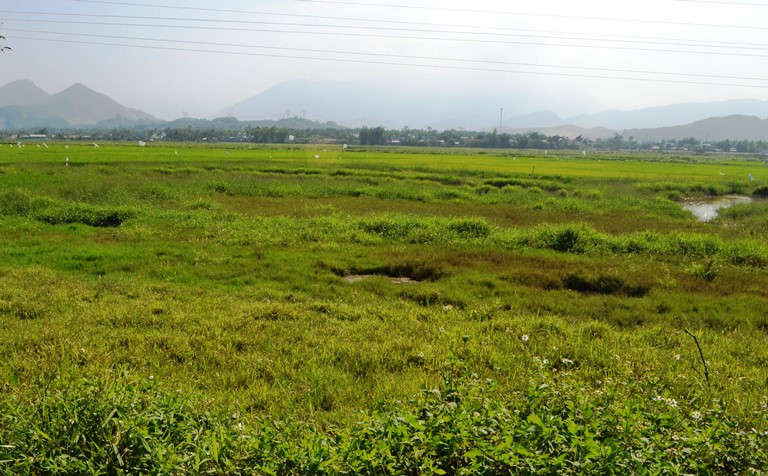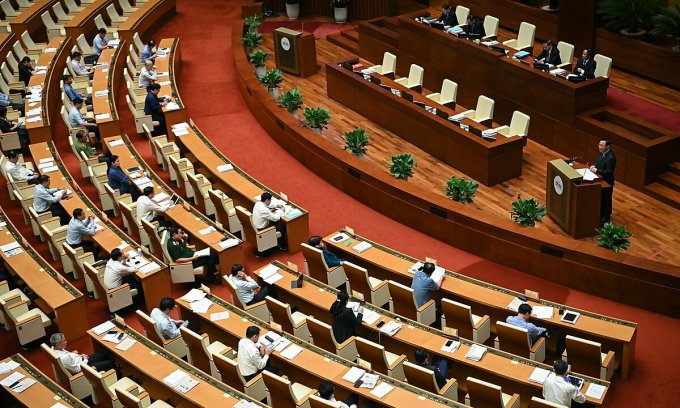How does it cost to make a red book of reclaimed land in Vietnam?

Issues related to red book making are always of great interest to many people. Regulations on making red books for reclaimed land is also a question many people wonder about. So about the matter “How does it cost to make a red book of reclaimed land in Vietnam?” Let’s find out with LSX in the article below.
Legal grounds
- Land Law 2013
What is reclaimed land?
Currently, reclaimed land has not been defined specifically.
However, previously, in Clause 1, Article 2 of Circular 52/2014/TT-BNNPTNT, reclaimed land was left fallow, other land was planned for agricultural production approved by competent authorities.
According to Clause 2, Article 9 of the 2013 Land Law, the State encourages land users to invest in labor, materials and capital, and to apply scientific and technological achievements to the reclamation, restoration, reclamation, and land reclamation. area of bare land, barren hills and land with uncultivated water surface to be used according to master plans and plans on land use.
Can reclaimed land be issued with a red book?
According to Article 101 of the Land Law 2013, the conditions for granting a land use right certificate without a land use right document are as follows:
– Households and individuals that are using land before July 1, 2014 without having the papers specified in Article 100 of the 2013 Land Law shall be granted a certificate of land use right and are not required to pay use fees. land with the following conditions:
+ Having permanent household registration in the locality and directly engaged in agricultural, forestry, aquaculture, and salt production in areas with difficult socio-economic conditions, areas with special socio-economic conditions; special difficulties;
+ Being certified by the People’s Committee of the commune where the land is located is a stable land user;
– Households and individuals currently using land do not have the documents specified in Article 100 of the Land Law 2013 but the land has been used stably before July 1, 2004 and has not violated the law on land. A certificate of land use right shall be granted with the following conditions:
+ Being certified by the commune-level People’s Committee that the land is not disputed;
+ Conform to land use planning, detailed urban construction planning, rural residential area construction planning approved by competent state agencies, for the area where the planning is available.
* According to Clause 4, Article 22 of Decree 43/2014/ND-CP, households and individuals are using agricultural land due to self-reclamation and that land conforms to the land use planning approved by state agencies, if there is no dispute, the land use right shall be recognized by the State according to the limit set by the provincial People’s Committee;
If the limit is exceeded by the provincial People’s Committee, the excess area must be converted to lease.
Thus, for reclaimed land, if it meets the prescribed conditions, it will be granted a certificate of land use right.
If the area of reclaimed land exceeds the quota, the excess will be converted to lease.
Dossier for red book of reclaimed land
If you want to apply for a red book of wild land, you will have to prepare the following documents:
• An application form for a land use right certificate, made according to the prescribed form.
• Information on documents certifying the origin of the land being used (land with full papers as prescribed in Article 100 of the 2013 Land Law) or a certificate of flower land issued by the Commune People’s Committee.
• Information on the minutes of the approval of the approval council.
• 2 land registration fee declarations (Specified according to form 01/LPTB if any).
• 2 land use levy declarations (Form No. 01-05/TSDD if any).
• 2 Personal income tax return (Form 11/TK-TNCN if any).
• 2 copies of information about other documents related to land use levy exemption or reduction (if any).
• 2 land use levy debit applications (if any).
• Information on court judgments, judgment execution minutes and judgment enforcement decisions at competent state agencies, decisions from all levels (if any).
Where to submit the application for red book of reclaimed land?
After preparing the land registration file, you will proceed to submit it at the District Land Registry Office
After submitting the application at the district land registration office, the receiving officer will directly check the application information.
You fulfill your financial obligations after receiving the tax notice (if any). You will then submit your tax receipt directly to the reception and receive a certificate appointment slip.
How long does it take to make a red book of reclaimed land?
The time limit for granting certificates of land use rights and ownership of houses on land is not more than 30 days from the date of receipt of valid dossiers; no more than 40 days for communes in mountainous, island, deep-lying and remote areas, areas with difficult socio-economic conditions, and areas with extremely difficult socio-economic conditions.
This time does not include the time of holidays and holidays as prescribed by law; does not include the time to receive the dossiers at the commune, the time to fulfill the financial obligations of the land users; does not include the time for consideration and handling for the case of land use in violation of the law, the time for soliciting expertise.
Results of settlement of administrative procedures must be returned to land users and owners of land-attached assets within 03 working days from the date of receipt of settlement results.
How does it cost to make a red book of reclaimed land in Vietnam?
Land use fee when issued with Red Book
The land use fee when issuing the Certificate (Red Book, Pink Book) for reclaimed land is divided into different cases:
Case 1: When granting a Certificate (recognition of land use rights) to households and individuals that have been using it stably since before October 15, 1993 without having the land use right documents specified in Clause 1 of this Article. 1 Article 100 of the 2013 Land Law.
Case 2: When granting a certificate (recognizing land use rights) to households and individuals using from October 15, 1993 to before July 1, 2004 without documents on use rights land specified in Clause 1, Article 100 of the 2013 Land Law.
Case 3: When issuing a Certificate (recognizing land use rights) for reclaimed land from July 1, 2004 to before July 1, 2014
Land reclaimed in the period from July 1, 2004 to before July 1, 2014 is considered land in violation of the land law because of using land in the field without completing the procedures for land allocation or lease land in accordance with the law.
Clause 4, Article 2 of Decree 123/2017/ND-CP stipulates that land has illegal origins as prescribed in Article 22 of Decree 43/2014/ND-CP. The land use is as follows:
– 100% of land use levy must be paid at the specific land price at the time the decision on recognition of the land use right is issued. In other words, the payable land use levy is calculated according to the specific land price set by the People’s Committee of the province or centrally run city (the specific land price is not fixed in advance).
– Even though they are required to pay 100% of the land use levy at the specific land price, but have papers proving that they have paid the land use levy, the paid amount will be deducted from the payable land use levy; the deduction does not exceed the amount of the obligation to pay.
Particularly for the case of using land with other construction works (not houses), if granted a certificate of land use right for non-agricultural production and business, such as the form of land allocation with the collection of use levy with a duration of use Long term use:
100% of land use levy must be paid at the specific land price (the land price set by the provincial-level People’s Committee) of the type of non-agricultural production and business land with the highest useful life specified in Clause 3, Article 126. Land Law 2013 at the time of the decision on recognition of land use rights.
In this case, when granted, the type of land for non-agricultural production and business must be considered to determine what type of land is used as a ground for the construction of industrial parks, industrial clusters, and export processing zones; land for non-agricultural production establishments; commercial land, services,…
Registration fee (registered tax)
* Free registration fee
Exemption from registration fee upon first issuance of a certificate of land use right for agricultural land reclaimed by households or individuals in accordance with the planning approved by a competent state agency. there is a dispute (Clause 6, Article 9 of Decree 140/2016/ND-CP).
* How to calculate registration fee when issuing Certificate
Article 5 of Decree No. 140/2016/ND-CP and Clause 1, Article 1 of Decree No. 20/2019/ND-CP stipulate the calculation of registration fee when granting a Certificate as follows:
Registration fee payable = 0.5% x (Price of 1m2 of land in the Land Price List x Area)
– The price of 1m2 of land for registration fee calculation is the land price specified in the land price list promulgated by the People’s Committee of the province or city under central authority at the time of issuance of the Certificate (the time of fee declaration before the date of registration).
– Land area is the entire area under the lawful use right of the certificate-granted organization or individual, determined and provided by the land registration office to the tax authority.
Certificate issuance fee (cover fee)
According to Circular 85/2019/TT-BTC, the fee for the issuance of the Certificate (the fee for making book covers) is regulated by the People’s Councils of the provinces and centrally-run cities, so the rate of collection varies from province to province.
Although the collection rates are not the same between provinces and cities, the common point is that the collection rate is from 100,000 VND or less/book/issue; only a few provinces collect 120,000 VND.
This is the least amount and is fixed in advance, if people want to know, just look at the resolution of the People’s Council of the province or city where the land plot is located.
In addition, there may be an additional fee for appraisal of documents, measurement fee, annual land use tax if not yet paid and service fee if hiring someone else to do it.
Services of LSX
Prestigious professional services: Firstly, the team of consultants and consultants for many years in the field of civil status, and customer support.
On-time: Certainly, with the motto “Get your lawyer right at your fingertips”, we ensure the service always performs on time. The rights and interests of customers always come first.
Cost: Besides, LSX’s service costs are highly competitive; depending on the nature of the particular case. So, we want our guests to have the best possible service experience. Therefore, costs which guaranteed to be the most suitable and economical for customers.
Confidentiality of client information: Finally, all brand information of client LSX will be 100% confidential.
Please contact us immediately if you have any questions about “How does it cost to make a red book of reclaimed land in Vietnam?”
Contact LSX
Finally, hope this article is useful for you to answer the question about “How does it cost to make a red book of reclaimed land in Vietnam?” If you need any further information, please contact LSX Law firm: at +84846175333 or Email: [email protected]
Please see more
- How to settle a land dispute when having a red book in Vietnam?
- What to do when landlord unilaterally terminate tenancy contract in Vietnam?
- Land valuation income method in Vietnam
Frequently asked questions
Making a red book of reclaimed land requires paying three basic types of costs:
-Land use fee when issued with Red Book
Registration fee (registered tax)
-Certificate issuance fee (cover fee)
According to Circular 85/2019/TT-BTC, the fee for the issuance of the Certificate (the fee for making book covers) is regulated by the People’s Councils of the provinces and centrally-run cities, so the rate of collection varies from province to province.
Although the collection rates are not the same between provinces and cities, the common point is that the collection rate is from 100,000 VND or less/book/issue; only a few provinces collect 120,000 VND.
How much is the registration fee when making a red book of reclaimed land?
Article 5 of Decree No. 140/2016/ND-CP and Clause 1, Article 1 of Decree No. 20/2019/ND-CP stipulate the calculation of registration fee when granting a Certificate as follows:
Registration fee payable = 0.5% x (Price of 1m2 of land in the Land Price List x Area)
The price of 1m2 of land for registration fee calculation is the land price specified in the land price list promulgated by the People’s Committee of the province or city under central authority at the time of issuance of the Certificate (the time of fee declaration before the date of registration). contacts).
Land area is the entire area under the lawful use right of the certificate-granted organization or individual, determined and provided by the land registration office to the tax authority.
Conclusion: So the above is How does it cost to make a red book of reclaimed land in Vietnam?. Hopefully with this article can help you in life, please always follow and read our good articles on the website: lsxlawfirm.com




